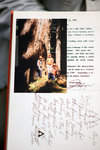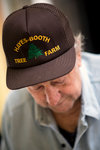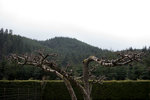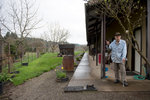







The Hayes-Booth Tree Farm has sat on a secluded patch of land outside of Vader for more than 60 years. By simply driving by, it would be impossible to know the owner may hold knowledge of a holdover from ancient history.
Paul Hayes, 89, has been in the forestry industry in the Pacific Northwest and beyond since 1955. Standing on his front porch, he pointed to the tree-lined hillside. He said nearly every tree on the hill is one he’s planted over the years.
Hayes was quick to turn the conversation from himself to a Lewis County relic — a tree with a 10-foot or greater diameter he found in the 1950s near Pe Ell.
“The only big standing tree that we know about is this one in Lewis County,” he said.
The Douglas fir tree he’s eager to talk about could be around 1,000 years old, he said. While it’s located on Weyerhaeuser property, he has pictures of the behemoth.
One picture from the 1990s that hangs in his home office shows himself, George Weyerhaeuser and another man standing next to the massive tree. The tree was dedicated to John Markham, a prominent individual in Centralia in the past who donated a stuffed bengal tiger to Centralia High School.
Hayes said at the time there was a sizeable dedication ceremony for the tree.
“This tree, when I first saw it, it was still in a stand of second-growth timber,” Hayes recalled.
The area the tree sits in was initially logged in the 1920s, Hayes said. Because of the size of the tree even then, it was left to grow like it had for centuries before.
If the tree is still standing, which Hayes said is likely, it would be a remnant of the old-growth history of Lewis County, which used to see groves of trees that regularly were 8-feet in diameter.
“The day of old growth logging is history,” he said. “No more one-log loads, those days are all history.”
He’s been trying to get a permit from Weyerhaeuser to take groups of locals, especially high school seniors, to see the tree. So far, he hasn’t had success.
Weyerhaeuser’s current management shut down public access to their lands outside of hunting season, Hayes said.
While this was done because people trashed parts of the forest, Hayes said he also thinks Weyerhaeuser could develop a process to manage the forest for harvest and public access.
It’s especially important to the 89-year-old because he hopes that appreciation for the history of not only logging but the forest itself will be passed on to younger folks.
“I’d like to be able to see the younger generation know this is still available,” he said.
Hayes said he hopes that Weyerhaeuser will allow access to the tree in the future.
“This is a one and only type situation and it should be available to the public,” he said.
The Chronicle will be following up with Hayes and Weyerhaeuser in future editions to possibly try and gain access to the tree for more coverage.
Walking through his humble home on his tree farm, it also becomes evident that forestry is more than an occupation for Hayes but rather a way of life.
His office is full of books on the history of logging in the Pacific Northwest and beyond, and his large garage is a verifiable treasure trove of artifacts.
These include old saws, springboards, oil jars, pictures and even prospecting equipment like a dumpy level from the 1920s when an abandoned railroad, which runs through his property, was constructed.
Hayes graduated high school in California in 1945, just in time to join the military and help the rest of the world rebuild. During that time, timber exports were booming as nations across the world were left in tatters following World War II.
He returned to the states and found his way to the University of Washington where he started studying engineering. He quickly figured out he wanted something else out of life.
“I thought I wanted to go back into the country, and I figured that’s what forestry would get me,” he said.
Consequently, for more than 60 years, Hayes has worked the tree farm, which now is full of towering trees he planted in his 20s, and he’s still planting saplings and coordinating harvests.